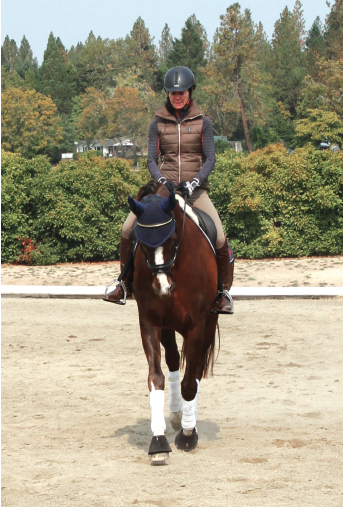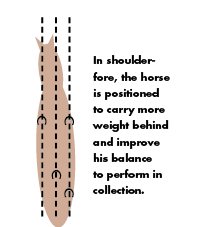German dressage master Gustav Steinbrecht said: “Ride your horse forward and make him straight!” Almost every rider has heard this sentence before. In some arenas in my native Germany, the phrase is painted on the wall. These eight words make up one of the foundation principles of dressage training. I will explain what straightness means and how you can achieve it.

Straightness Defined
A horse is straight when his body is properly aligned from poll to tail. When he travels on a straight line, he should be straight along the length of his body. On straight or curved lines, the hind legs should step precisely behind the front legs. In lateral work, the horse’s hind legs should move in the direction of movement and should not step out from under the horse.
If a horse is straight the rider can feel an equal contact in both hands and even weight in the stirrups and seat bones. Circles can be performed equally easily in both directions with only one set of tracks being left on freshly groomed footing. The horse’s ears are level without the horse tilting his poll.
By nature, horses are crooked. They are usually hollow on one side and stiff on the other side. For example, a horse is hollow right and stiff left if he is most comfortable carrying his shoulders too far to the left and the haunches to the right. This causes difficulty in bending the horse left on the stiff side because the shoulder is in the way. To the right, it is often easy to overbend in the neck, but the haunches want to come in on the hollow side. The supple horse can move his neck, shoulders and haunches equally in both directions. This erases any resistance in the topline and loosens the entire musculature of the horse. Only a horse who is supple can be straight.
Benefits
Here are the benefits of a straight horse:
• Straightness promotes soundness in the horse. Crookedness can create muscle pain and tightness. Over time, this causes muscle deficiency and even changes in joints and bones.
• Straightness is necessary for improved throughness. The rider’s aids can only influence all parts of the horse if he is supple and straight.
• The straight horse is more likely to stay in front of the rider’s legs and will accept the contact with the bit.
• Straightness is also the prerequisite for collection (Straightness appears directly below Collection on the Training Scale). Only a horse who is familiar with and accepts the aids for straightening work can collect because he can bear more weight behind instead of swinging the hindquarters to either side.
• A straight horse and rider will fulfill the requirements of a dressage test with harmony and ease, the main criteria of Submission in the Collective Marks of your test.
• The goal of straightening the horse is to increase the effectiveness of the pushing and weight-carrying power of the hindquarters with the result that the horse’s paces become more expressive.
Suppling and Straightening Exercises
For the horse to be suppled and straightened, the rider needs a correct and balanced position with hands independent from the seat and leg. From this correct position, the rider needs the understanding of the diagonal aids: inside leg toward the outside rein.
To supple the horse, I use many exercises that are considered straightening bending work. Every correct bending line, such as corners, circles, loops and serpentines, can gymnasticize the horse. When turning, make sure the neck, shoulders and hindquarters are all along the line of travel with the horse’s spine following the curve of the movement. Use the diagonal aids to bend the horse in his body. Your inside leg directs the inside hind leg so it carries the horse’s weight under his midline and creates the bend under the saddle so the horse reaches through his body toward the outside rein. This helps improve flexibility and suppleness through the horse’s topline.

When the horse is supple and he understands the diagonal aids, you can ride him in the straight position—which is known as shoulder-fore—when he is flexed in the poll slightly to the inside but with the neck straight in relation to his body. The rider uses the diagonal aids to ask the horse to step his inside hind leg directly under his midline, where it can be seen landing in between his two front legs. The outside hind leg should step right behind the outside front leg. The position gives the rider control of the horse’s body, since she must be able to adjust the poll, neck, forehand and haunches to achieve shoulder-fore. From there, the horse is positioned to carry more weight behind and improve his balance to perform in collection. The horse should be in shoulder-fore all the time, on straight and bent lines and in all three gaits. The canter is an asymmetrical gait and the biomechanics of the horse tend more toward crookedness than in the symmetrical walk and the trot. Riding the horse in a shoulder-fore position in both directions in the canter often requires more attention and is necessary for straightness.
Advanced straightening exercises include all the lateral work, such as shoulder-in, travers and half-pass. The exercises give you increased control of the horse’s body and further improve straightness.
With consistent correct training in straightness, the horse and rider will understand it better and become stronger to maintain the position of shoulder-fore. However, realize this is an ongoing process, which needs attention during every training session.
Sabine Ense is a USDF bronze and silver medalist and a USDF “L” Education Program graduate with distinction. She has competed at the FEI level in both the U.S. and her native Germany. Based in Grants Pass, Oregon, she owns and operates Lone Pine Stables (lone-pine-stables.com)











